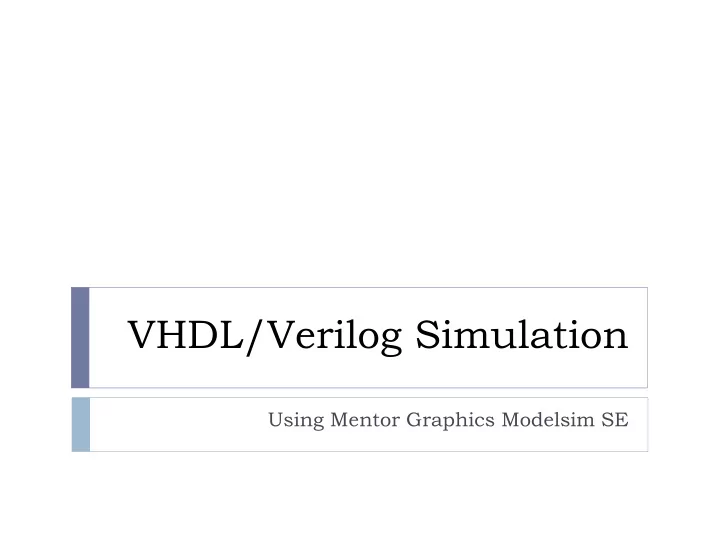

VHDL/Verilog Simulation Using Mentor Graphics Modelsim SE
VHDL/Verilog Simulation Tools Mentor Graphics “Modelsim PE” Student Edition: free download for academic course work: http://model.com/content/modelsim-pe-student-edition-hdl-simulation Full version in ECE PC labs: Broun 308 and 310 Full version on College of Engineering Linux Servers. Refer to ELEC 5250/6250 course web site: http://www.eng.auburn.edu/~nelsovp/courses/elec5250_6250/ Use sample .bashrc file provided under “useful CAD links” to set system environment/paths Additional information on the ELEC 4200 web page: http://www.eng.auburn.edu/~nelsovp/courses/elec4200/elec4200.html Aldec “Active-HDL” Student Edition: free download at: http://www.aldec.com/en/products/fpga_simulation/active_hdl_student Full version installed in ELEC 4200 lab (Broun 320)
ASIC Design Flow Behavioral Verify Model Function VHDL/Verilog Synthesis DFT/BIST Gate-Level Verify & ATPG Netlist Function Full-custom IC Test vectors Transistor-Level Verify Function Standard Cell IC Netlist & Timing & FPGA/CPLD Physical DRC & LVS Verify Layout Verification Timing Map/Place/Route IC Mask Data/FPGA Configuration File
Behavioral Design & Verification (mostly technology-independent) VHDL VHDL-AMS Create Behavioral/RTL Verilog Verilog-AMS HDL Model(s) SystemC SystemVerilog Simulate to Verify ModelSim Questa ADMS Functionality (digital) (analog/mixed signal) Synthesize Gate-Level Leonardo Circuit Spectrum (digital) Technology Libraries Technology-Specific Netlist to Back-End Tools
Project simulations Behavioral/RTL – verify functionality 1. Model in VHDL/Verilog Drive with “force file” or testbench Post-Synthesis 2. Synthesized gate-level VHDL/Verilog netlist Technology-specific VHDL/Verilog gate-level models Optional SDF file (from synthesis) for timing Drive with same force file/testbench as in (1) Post-Layout 3. Netlist back-annotated with extracted capacitances for accurate delays
Questa ADMS Analog-Digital Mixed-Signal Simulator Language neutral – mix any supported languages within a model Four simulation engines: Questa Digital: VHDL/Verilog (ModelSim/Questa Sim) Analog/mixed signal: VHDL-AMS/Verilog-AMS (Questa) Eldo – General purpose analog (SPICE) ADiT - Fast transistor level (SPICE) Eldo RF Invoke stand-alone or from Design Architect-IC PC and Student versions are “Modelsim PE”
Digital/Mixed-Signal Simulation VHDL,Verilog, VHDL-AMS, Verilog-A, SPICE Models Resource VITAL Libraries Working Design_1 IEEE 1164 Library Design_2 Input Simulation Questa ADMS Stimuli Setup Mixed-Signal Questa VHDL/Verilog, EZwave Eldo, VHDL-AMS, ModelSim/ or Xelga Eldo RF Verilog-AMS, Questa Analog View Results SystemC ADiT Digital (SPICE) SystemVerilog (VHDL,Verilog)
Modelsim Operational Structure and Flow Create working library work and map logical name work to that physical directory: • Command line: > vlib work > vmap work work • From Modelsim menu: File > New > Library Logical name Physical name can be anything. Enter full path name if not current directory.
Compile Verilog/VHDL model(s) Compiled models are placed in the working library From linux or Modelsim command line: vlog count4.v (Verilog model) vcom count4.vhd (VHDL model) From Modelsim menu: Select: Compile > Compile Select file in Navigator window and click Compile T o place the compiled model in a different library: Use compile option -work lib-name
Simulate a VHDL model From Modelsim menu select: Simulate > Start Simulation Verilog module VHDL entity Expand work library Select top-level model (design unit) Select time resolution for simulation Click OK to start simulation OR – in Modelsim Transcript window enter: vsim work.count4
Example: 4-bit binary counter VHDL model (count4.vhd) Create working library: vlib work Map name “work”: vmap work work Compile: vcom count4.vhd Simulate: vsim count4(rtl) ModelSim simulation-control inputs ModelSim “Macro” file (count4.do) T estbench (VHDL or Verilog) ModelSim results List (table) and/or Waveform (logic analyzer)
-- count4.vhd 4-bit parallel-load synchronous counter LIBRARY ieee; USE ieee.std_logic_1164.all; USE ieee.numeric_std.all; ENTITY count4 IS PORT (clock,clear,enable,load_count : IN STD_LOGIC; D: IN STD_LOGIC _VECTOR(3 downto 0); Q: OUT STD_LOGIC _VECTOR (3 downto 0); END count4; ARCHITECTURE rtl OF count4 IS SIGNAL CNTint : UNSIGNED(3 downto 0); -- counter internal state BEGIN PROCESS(clear, clock) -- synchronous load/count, asynchronous clear BEGIN IF (clear = '1') THEN CNTint <= "0000"; ELSIF (clock'EVENT AND clock='1') THEN IF (enable = '1') THEN IF (load_count = '1') THEN CNTint <= UNSIGNED(D); ELSE CNTint <= CNTint + 1; END IF; END IF; END IF; END PROCESS; Q <= STD_LOGIC _VECTOR (CNTint); END rtl;
Modelsim TCL “macro” file: count4.do add wave /clock /clear /enable /load_count add wave –hex /D /Q add list /clock /clear /enable /load_count add list –hex /D /Q force /clock 0 0, 1 10 -repeat 20 force /clear 0 0, 1 5, 0 10 force /enable 0 0, 1 25 force /load_count 0 0, 1 20, 0 35, 1 330, 0 350 force /D 10#5 0, 10#9 300 run 400 * To execute the macro from the Modelsim Transcript window, enter: do count4.do * To execute from the Modelsim menu, select: Tools > Tcl > Execute Macro (select file count4.do in the navigator window) * Individual commands can also be entered in the Modelsim Transcript window.
Count4 – Simulation waveform Clear Counting Parallel Load
Count4 – Simulation list window Clear Parallel Load Counting
Post-synthesis simulation (1) Compile the ADK standard cell library 1. Create an adk library: vlib adk 2. Compile the cell models: vcom $ADK/technology/adk.vhd –work adk 3. Compile the ADK components declaration package: vcom $ADK/technology/adk_comp.vhd –work adk 4. Map logical name “adk” to the physical directory: vmap adk adk
Post-synthesis simulation (2) Edit the synthesized VHDL netlist file produced by Leonardo (count4_0.vhd) to include the ADK component declarations package: -- Definition of count4 -- Thu Sep 21 10:48:09 2006 -- LeonardoSpectrum Level 3, 2005a.82 -- library IEEE; use IEEE.STD_LOGIC_1164.all; library adk; -- add these two lines use adk.adk_components.all; entity count4 is port (…..
Post-synthesis simulation (3) Compile the VHDL netlist: vcom count4_0.vhd Simulate the model: vsim count4 –do count4.do (count4.do is the “macro file” used earlier for the behavioral model) Verify that the synthesized circuit produces the same results as the behavioral circuit
Leonardo-synthesized netlist count4_0.vhd library IEEE; use IEEE.STD_LOGIC_1164.all; library adk; use adk.adk_components.all; -- ADDED BY VPN entity count4 is port ( clock : IN std_logic ; clear : IN std_logic ; enable : IN std_logic ; load_count : IN std_logic ; D : IN std_logic_vector (3 DOWNTO 0) ; Q : OUT std_logic_vector (3 DOWNTO 0)) ; end count4 ; architecture netlist of count4 is -- rtl changed to netlist by VPN signal Q_3_EXMPLR, Q_2_EXMPLR, Q_1_EXMPLR, Q_0_EXMPLR, nx8, nx14, nx22, nx28, nx48, nx54, nx62, nx126, nx136, nx146, nx156, nx169, nx181, nx183, nx185, nx187, nx189: std_logic ; (continue next slide)
Recommend
More recommend